Schema markup and why it is critical to local business
Today, when searching for information about a business, you are very likely to get your answer within the search results. Whether you’re looking for the phone number for Starbucks Customer Service, the weather in Chicago, or information about cupcakes, you search, and “bam!”, there’s the answer, without you needing to even click through to a website. See what I mean below...
McDonalds Customer Service Phone Number

Weather in New York
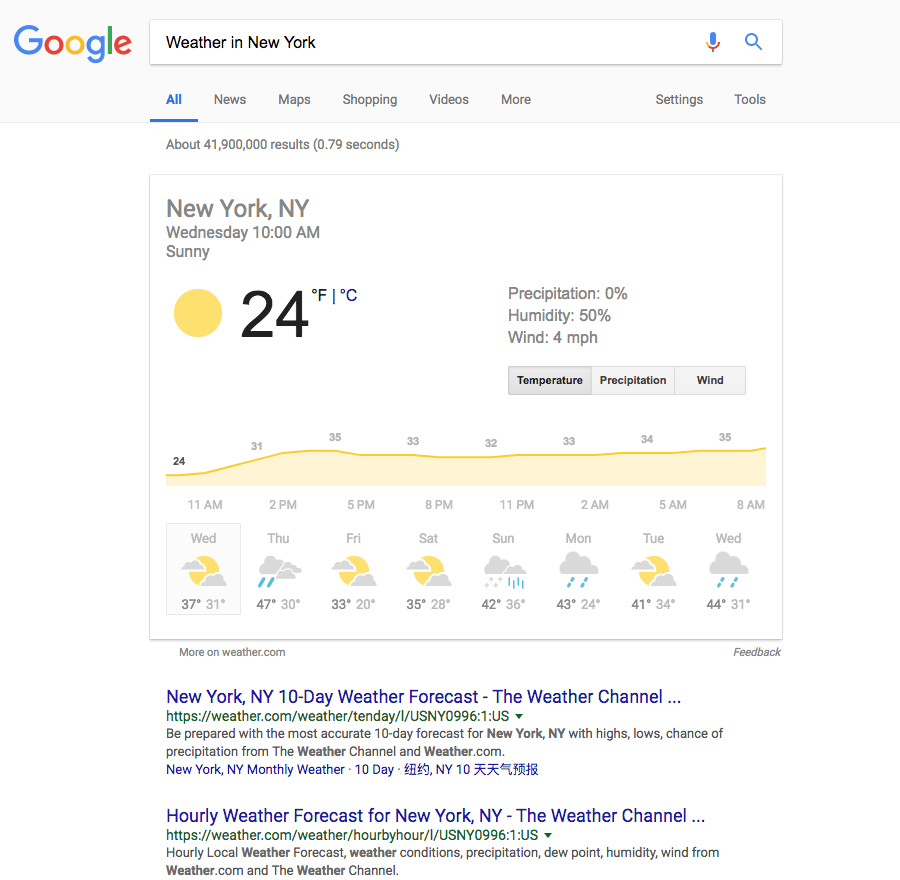
Cupcake Search
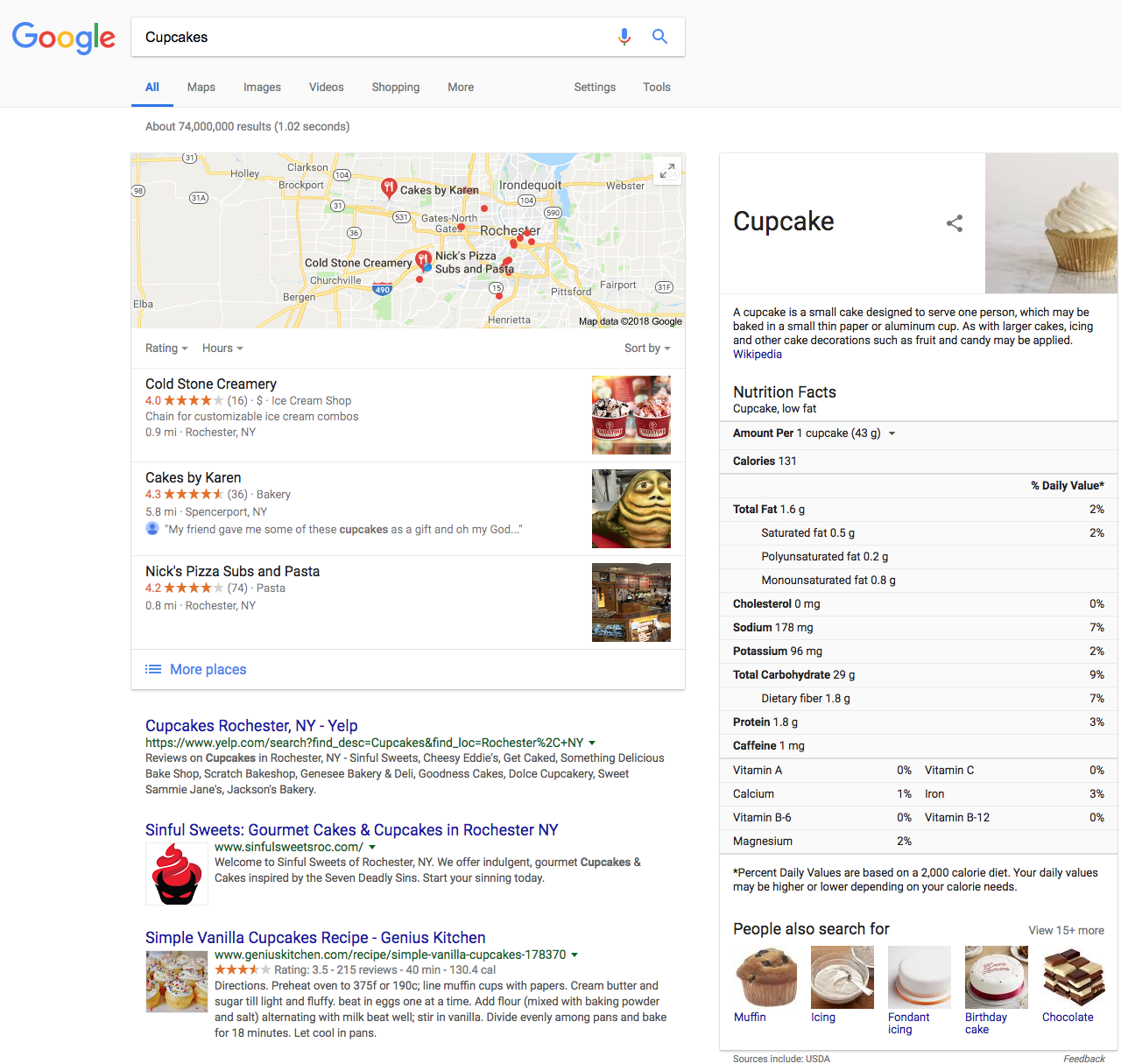
For searches like these, traffic is often not even going to your website, the users are staying within the search results to find what they're looking for. If that's the case, we need to make sure that our data is what's being displayed in those results, as opposed to our competitors. How do we do this? You have to make sure the search engines are able to understand the data on your site, which means your site needs to communicate to the search engine in their language, a language called Schema Markup.
What is Schema Markup and Structured Data?
Schema Markup, also known as Structured Data (and sometimes Structured Data Markup), is the language of search engines. The vocabulary, officially called schema.org, was created by Google, Yahoo, Bing, and Yandex in 2011 as a global standard vocabulary to help them better understand content on the web. It's quite brilliant when you think about it - the search engines created a language to help them explicitly understand web content, and then put the burden on us to adpot it, to help them do their jobs better.
To translate your content into Schema Markup you have to answer the question, “What is this page about?” Once you know what the page is about, you can pick a Schema Markup class (think of this as a definition), and describe it using a standard group of properties. Once you have all this information mapped out, you need to put it into Schema Markup code.
Schema Markup code comes in a variety of formats: Microdata, JSON-LD, and RDFa.
Schema Markup and Structured Data Code Types
For an overview of Schema Markup types, take a look at this list directly from Google.
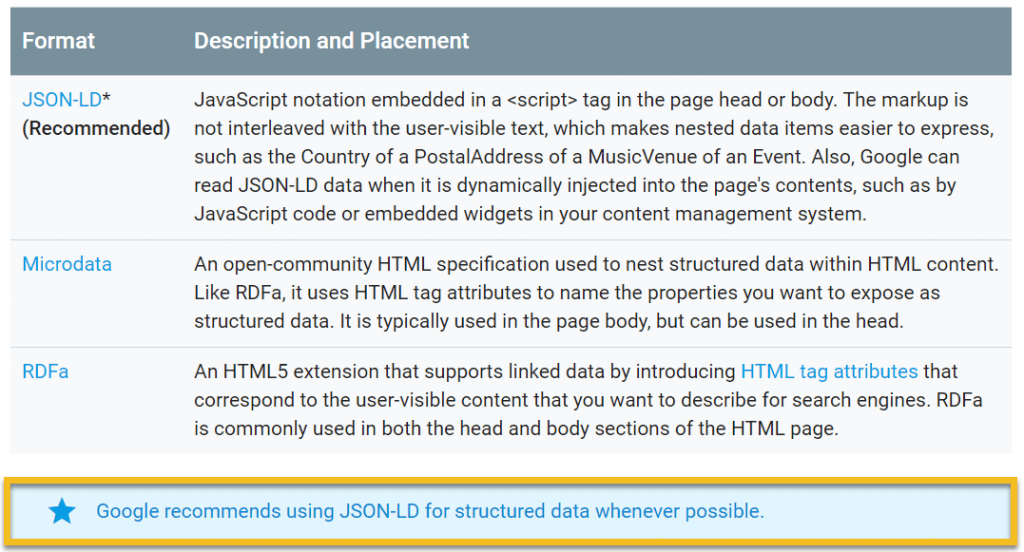
These days, Google prefers the markup in JSON-LD. Here’s a JSON-LD schema example:
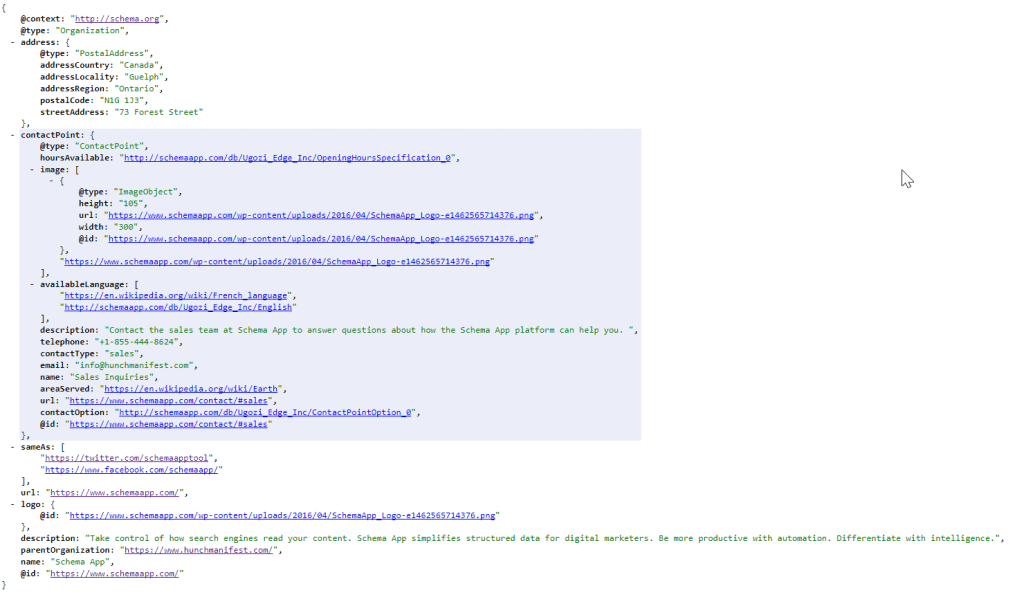
Rich Results Are Here to Stay
Businesses who adopt Schema Markup get rewarded with what are known as ‘rich results’ (previously known as rich snippets or rich cards) in search. These rich results range from product information and ratings to local business information, actions, information panels on the right-hand side of the screen, and more.
Specifically for Local Businesses, Google has created Local Business Listings and Place Actions. The Local Business listing is very similar to Google My Business (GMB) listing information, and the Place Action lets the user reserve, or order directly, from search results. It’s interesting to note that since they released this feature in Schema Markup, Google has added the ability to enter appointment type information in Google My Business. We’ll see how it evolves, and where Google wants you to manage this information – on a page or in GMB.
Note: These features today are with a limited group of initial providers.
Most recently, Glenn Gabe reported that he is seeing evidence that Schema Markup is being used to enhance Google Answer Boxes. So while Google says that the Answers in search results are not as a result of Schema Markup, there is evidence that they are adding flair to the answers.
Google’s features resulting from adopting Schema Markup have been accelerating. In 2017, we saw 10+ new announced features, and countless more that have never been officially announced, such as health information graphs and best answers. In addition to new features, we also saw 50+ updates to Google documentation and Schema.org vocabulary.
Because of the speed at which we see new features released, we made assumptions that Schema Markup was a strategic SEO strategy that Google was continuing to invest in as a way to help them understand. I mean, Google’s entire “search documentation” is on structured data! Now our assumptions have been confirmed.
At PubCon in November 2017, Google’s Gary Illyes spent quite a lot of time talking about Schema Markup, particularly stressing the importance of using it on websites. He said:
“Structured data is one of those things that I want you to pay lots of attention to this year.”
Why? He went on to share how Google has recently “launched a bunch of search features that are based on structured data”.
These most recent new Schema Markup types include, but are not limited to, new features for:
What is most exciting is that Gary then stated that Google is likely going to start “building lots of new features that rely on structured data.”
It looks like Google cares a lot about Schema Markup and Structured Data, which makes sense, because it allows them to explicitly understand what content is about, helping them serve their searchers better, and ensure they are giving a quality answer.
He even went as far as to say that:
“If you want your sites to appear in search features, implement structured data.”
For a long time, there has been a lot of discussion about whether Google is using Schema Markup for indexing and ranking. As it turns out, they are. Gary Illyes confirmed it during PubCon, as documented here by Jennifer Slegg from SEMPOST.
But don’t take my word for it; take it from Gary Illyes:
“[Add] structured data to your pages because, during indexing, we will be able to better understand what your site is about. And don’t just think about the structured data that we documented on developers.google.com. Think about any schema.org schema that you could use on your pages. It will help us understand your pages better, and indirectly, it leads to better ranks.”
Schema Markup Results in Higher Quality Traffic
Gary Ilyes stated that Google is using Schema Markup for ranking, as it makes their job easier. Last year, in a session called “How to Stand Out in Search with Structured Data” at Google IO, they shared several case studies. The case studies they shared from international brands illustrated the metrics as a result of implementing schema markup.
Here’s a sample of the case studies that show how Schema Markup and rich results help increase engagement and clicks online. The numbers are compelling:
- 25% higher click-through rate on pages with markup (Rotten Tomatoes)
- 35% increase in visits for recipes with markup (Food Network)
- 1.5% more time spent on pages and 3.6x higher interaction rate (Rakuten)
- 82% higher click-through rate for rich result pages (Nestle Faz Ben)
- 20% more clicks for pages with Schema Markup (La Fourchette)
The results our customers have achieved include appearing with rich results, in addition to an increase in the quality of the traffic to their site.
What do we mean here? We saw an increase in time on page, a decrease in bounce rate and an overall increase in leads or purchases. This means that the people that landed on the pages were looking for that information, and wanted to learn more or buy.
So it’s clear: Schema Markup improves your SEO and business metrics. If that’s not enough to motivate you to optimize your site with Schema Markup, maybe the fact that Schema Markup is the foundation for informing voice search and Personal Assistants will…
Your New Sales Team: Voice Search & Personal Assistants
According to ComScore, by 2020 50% of all searches will be voice searches. Think that 2020 is really far away, so you don’t have to worry about it? Think again.
The number of devices used to make voice searches is exploding. A year ago we may not have believed that our kids would be asking Google Home, “What does a Flamingo sound like?” during breakfast, but that is now my reality.
How many of your friends and family got Alexa or Google Home for Christmas? Research says that Google has sold 7+ Million Google Home Devices and Amazon close to 21 million, all in the last year. These new devices only add to the existing Siri, Cortana, and Google Assistant installs on our phones. Assistants are here, and they’re growing fast.
And this is just the beginning. Earlier this month Google announced that they would be partnering with Altec Lansing, Anker Innovations, Bang & Olufsen, Braven, iHome, JBL, Jensen, LG, Lenovo, Klipsch, Knit Audio, Memorex, RIVA Audio, SōLIS, and Sony. These new devices will be voice and Assistant-enabled and will include a smart screen.
What Does This Mean for Local SEO?
It means that, whether we like it or not, we have to start optimizing for Assistants as well as search engines. In addition to losing control of our brand because Google is providing answers in search (like the weather, and phone numbers), now Assistants will be “answering” questions and guiding customers through their day, while never browsing a web page.
Google published a short video showing a “day in the life” with Google Assistants. This video is awesome. In 2 minutes they show how our day can be transformed by being informed and guided by an Assistant. Examples include guidance to a first appointment, advice on what to make for dinner, from anywhere, while never clicking on a business website.
So How Do You Take Control?
Good news! If you add Schema Markup to your website, Google will automatically make the marked-up information “searchable” by Assistants, resulting in your customers being able to search your content through voice as well as new visitors being able to reach you through Answer Boxes. What a great way to engage your customers and be “voice ready” with no additional effort (since you are already doing schema for SEO purposes)! Today, Google Assistant supports actions for News, Recipes, and Podcasts, but many, many more are clearly on their way.
How do you make your business show up through this new voice medium? Start by creating relevant content that answers the questions your customers are asking. Ask your sales team, customer service staff, or receptionist for the most common questions they get from your customers today. Once you have this content created and published to your website, add Schema Markup to them! The schema.org vocabulary includes markup for almost all types of content – they even have a definition for Public Toilets!
Q&A Schema Markup
Question and Answer schema markup is perfect for FAQ pages. You can define the questions with Question markup, define what the question is about (your business, product, etc.), and then link it to the answer with Answer Markup.
The stakes are high for these machines to get the answer right since they only give one answer, so make sure they know you are an expert and can guide them to the right answer.
Another actionable step you can take to figure out what your customers are asking these assistants is to look at the long-tail keywords in Google Search Console. You will start to see keywords showing up for How? When? Can? or other human-phrased or ‘natural language’ questions. This is a great place to start for content creation and Schema Markup!
Chatbots Use Your Schema Too
Chatbots were a hot topic in 2017, and continue to be on the minds of marketing teams in 2018. Everyone wants to be able to say they have sexy AI on their site, so let’s break this down:
Chatbots answer questions for users, based on the information that they can derive from the business. To figure out information about the business, they need to understand common questions and answers, key entities (things) defined on the site, and how they relate.
Sound familiar? Yes, chatbots need to understand your business and content, just like Google. What does Google do to understand web content? It reads Schema Markup. Like search engines, chatbots need to understand information on a page, so that they can find the answers for the interactions on their site. Schema Markup can serve as a foundational knowledge graph for chatbots, so when you optimize your site for organic search, you can also be taking one step towards enabling your marketing team’s dream chatbot.
How to Get Started with Schema Markup
Schema Markup is critical to being understood in 2018. To get started, we recommend you firtly add Schema Markup to define your business. We recommend you add the Schema Markup for the business on your homepage. use detailed Schema Markup to describe exactly what type of local business it is, and use Wikipedia to make it very specific.
Schema.org has defined a LONG list of Local Business Types. Always pick the most specific type. I recommend following the Ultimate Guide for Local Business Schema Markup to guide you on what properties to use to get the best results. This guide takes you through the process of creating your Schema Markup with plenty of detail, and using Wikipedia and maps to create rich, robust markup.
The reason that your homepage/business is the first thing to optimize is so that we can refer to it with your other pages. For example, if you offer Services, we want to define your business as the organization that is delivering the service. If you manufacture a product, we want to define the business as the Manufacturer.
After you’ve optimized your homepage, I recommend you also add markup to your contact page (in Schema Markup this is known as a Contact Point) followed by your services and products.
2018 is the Year of Schema Markup
Google, Personal Assistants, and chatbots use it to understand your business and this resulting in more clicks, higher quality traffic, and the benefit of being understood. Now is the time to get started, so that your brand and website are ready for the explosion of machines that want to understand your business and send you more customers.
Enjoyed this article?
Here's a few more that may interest you.
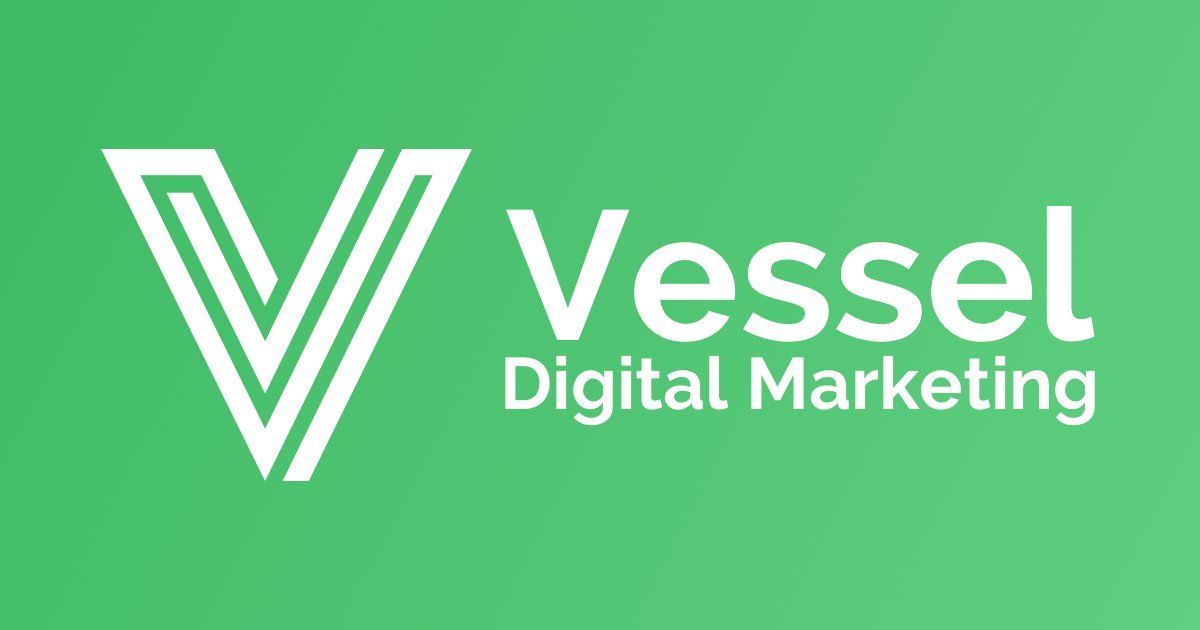

Want to know more?
Set up a [free] consultation.
We will walk through your current website and discuss the vision for your new website, as well as any other digital marketing needs you may have.

